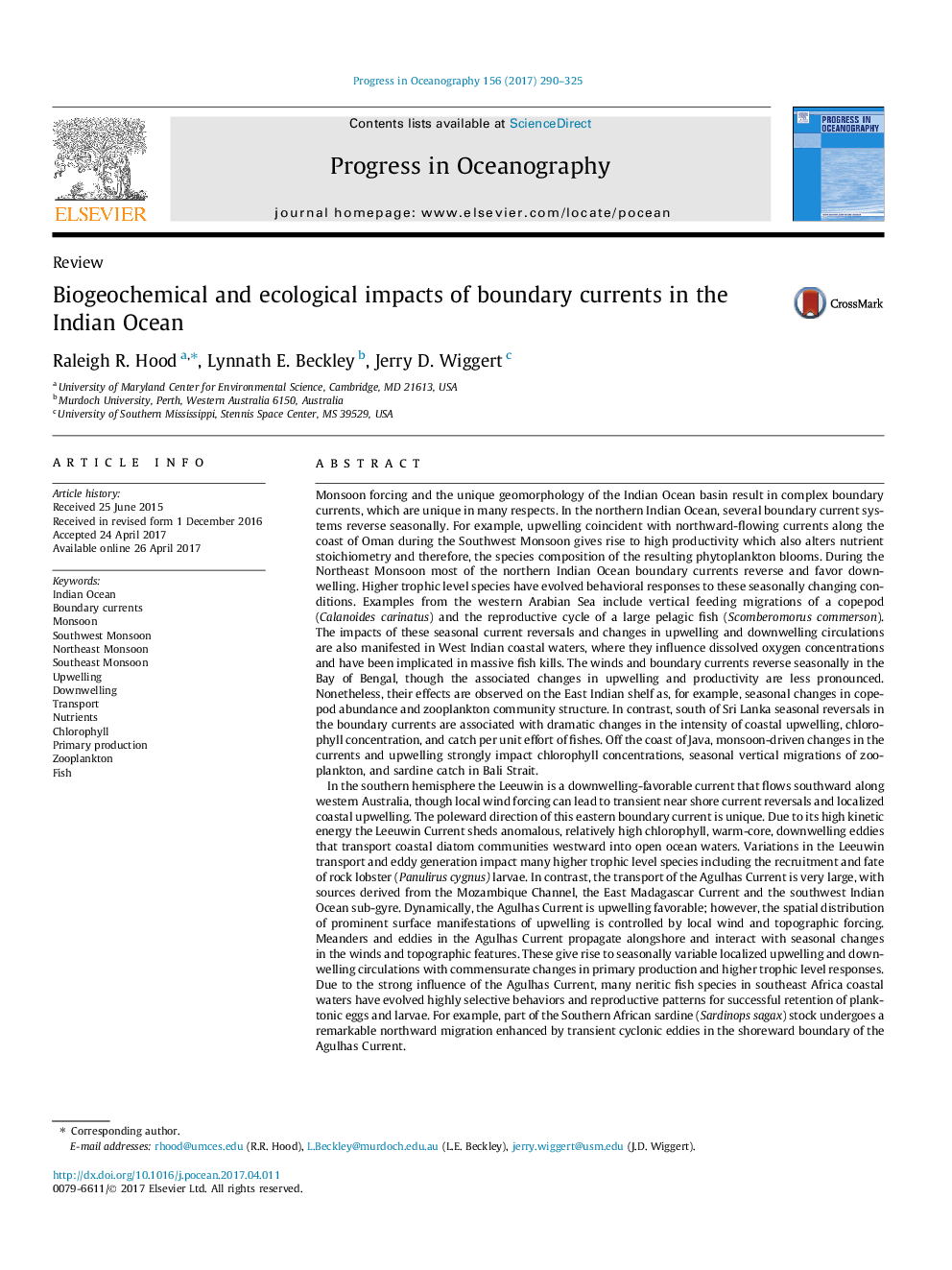| کد مقاله | کد نشریه | سال انتشار | مقاله انگلیسی | نسخه تمام متن |
|---|---|---|---|---|
| 5766489 | 1627902 | 2017 | 36 صفحه PDF | دانلود رایگان |
- Indian Ocean (IO) boundary currents are complex compared to the Atlantic and Pacific.
- The currents in the northern IO reverse seasonally and have large biological impacts.
- The Leeuwin Current flows poleward and sheds seaward-propagating eddies.
- The Agulhas Current is very large and generates eddies that propagate alongshore.
- Leeuwin and Agulhas Current eddies also have large biological impacts.
Monsoon forcing and the unique geomorphology of the Indian Ocean basin result in complex boundary currents, which are unique in many respects. In the northern Indian Ocean, several boundary current systems reverse seasonally. For example, upwelling coincident with northward-flowing currents along the coast of Oman during the Southwest Monsoon gives rise to high productivity which also alters nutrient stoichiometry and therefore, the species composition of the resulting phytoplankton blooms. During the Northeast Monsoon most of the northern Indian Ocean boundary currents reverse and favor downwelling. Higher trophic level species have evolved behavioral responses to these seasonally changing conditions. Examples from the western Arabian Sea include vertical feeding migrations of a copepod (Calanoides carinatus) and the reproductive cycle of a large pelagic fish (Scomberomorus commerson). The impacts of these seasonal current reversals and changes in upwelling and downwelling circulations are also manifested in West Indian coastal waters, where they influence dissolved oxygen concentrations and have been implicated in massive fish kills. The winds and boundary currents reverse seasonally in the Bay of Bengal, though the associated changes in upwelling and productivity are less pronounced. Nonetheless, their effects are observed on the East Indian shelf as, for example, seasonal changes in copepod abundance and zooplankton community structure. In contrast, south of Sri Lanka seasonal reversals in the boundary currents are associated with dramatic changes in the intensity of coastal upwelling, chlorophyll concentration, and catch per unit effort of fishes. Off the coast of Java, monsoon-driven changes in the currents and upwelling strongly impact chlorophyll concentrations, seasonal vertical migrations of zooplankton, and sardine catch in Bali Strait.In the southern hemisphere the Leeuwin is a downwelling-favorable current that flows southward along western Australia, though local wind forcing can lead to transient near shore current reversals and localized coastal upwelling. The poleward direction of this eastern boundary current is unique. Due to its high kinetic energy the Leeuwin Current sheds anomalous, relatively high chlorophyll, warm-core, downwelling eddies that transport coastal diatom communities westward into open ocean waters. Variations in the Leeuwin transport and eddy generation impact many higher trophic level species including the recruitment and fate of rock lobster (Panulirus cygnus) larvae. In contrast, the transport of the Agulhas Current is very large, with sources derived from the Mozambique Channel, the East Madagascar Current and the southwest Indian Ocean sub-gyre. Dynamically, the Agulhas Current is upwelling favorable; however, the spatial distribution of prominent surface manifestations of upwelling is controlled by local wind and topographic forcing. Meanders and eddies in the Agulhas Current propagate alongshore and interact with seasonal changes in the winds and topographic features. These give rise to seasonally variable localized upwelling and downwelling circulations with commensurate changes in primary production and higher trophic level responses. Due to the strong influence of the Agulhas Current, many neritic fish species in southeast Africa coastal waters have evolved highly selective behaviors and reproductive patterns for successful retention of planktonic eggs and larvae. For example, part of the Southern African sardine (Sardinops sagax) stock undergoes a remarkable northward migration enhanced by transient cyclonic eddies in the shoreward boundary of the Agulhas Current.There is evidence from the paleoceanographic record that these currents and their biogeochemical and ecological impacts have changed significantly over glacial to interglacial timescales. These changes are explored as a means of providing insight into the potential impacts of climate change in the Indian Ocean.
Journal: Progress in Oceanography - Volume 156, August 2017, Pages 290-325
